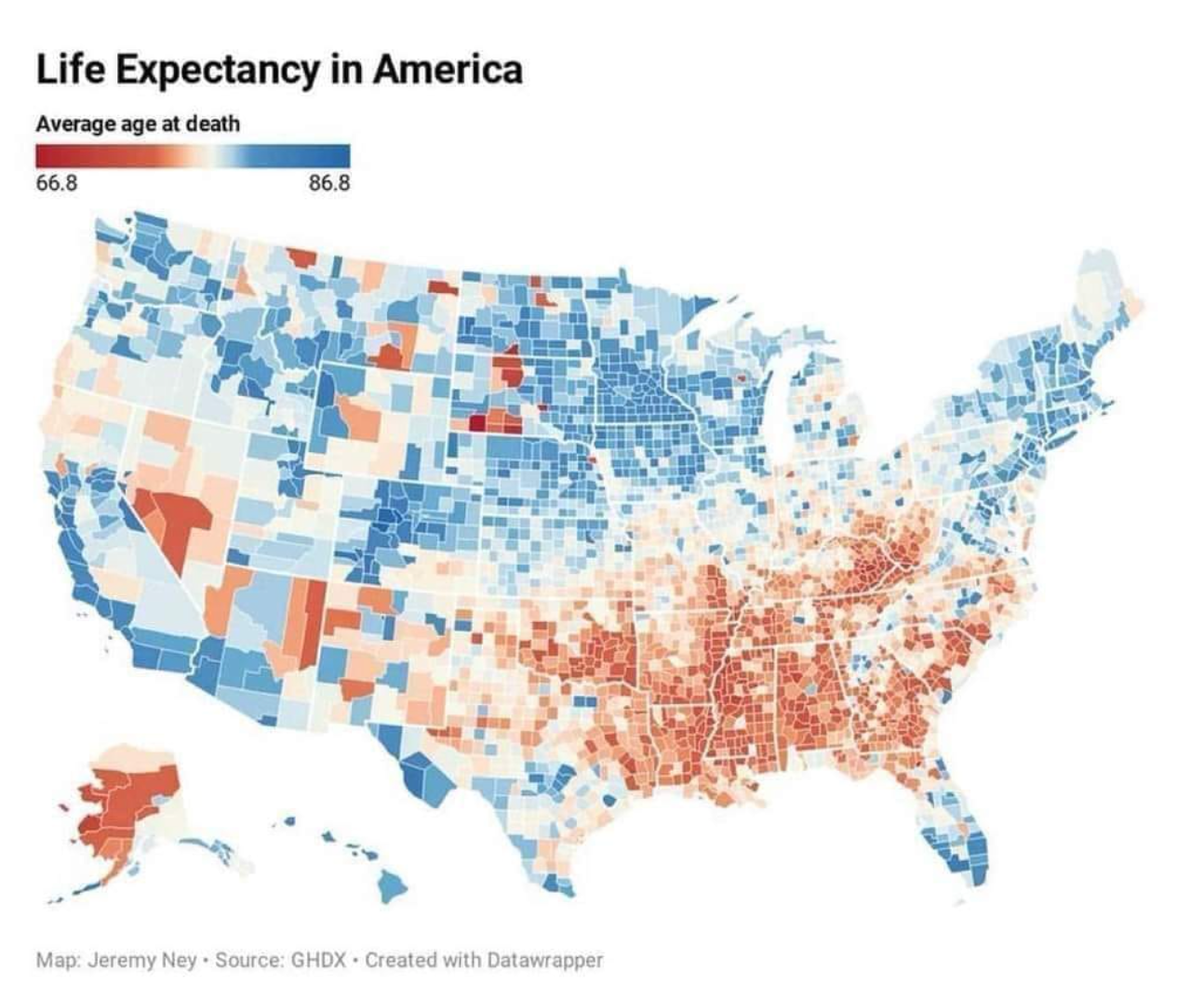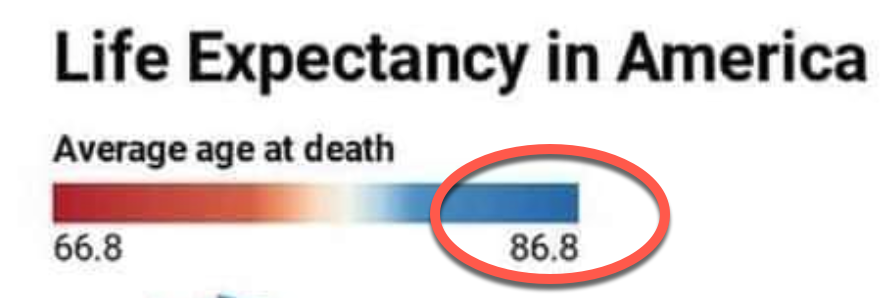
Most men overlook this organ, but it’s so important
Story-At-a-Glance
Hey, Matt Cook here, and most men are taking care of their hearts and their guts…
They’re looking out for lungs, and even their male organ…
But this other vital organ — which acts as the barrier between deadly toxins and the rest of your body…
It’s often getting ignored!
And it’s not men’s fault — most doctors are ignoring it too.
Let’s change that together, and I’ll show you how it has the potential to add decades to your life…
Unsubscribe | Report as spam | Change email preferences
—-Important Message—-
Find yourself on the map to see how long you’ll live
Take a look at this map that is color coded to show the average life expectancy of men in different parts of the U.S.:
There’s a lot to unpack here — but you know the 1 thing that stands out the most to me?
Right here, in the corner of the picture:
Most men are apparently only living to 86 or 87 years old.
But what if you could live much longer? Decades longer.
I’ve found evidence of men living to 110 and 120 all over the world, including the U.S.
And I am planning on doing the same.
I put my roadmap to 120 into a book called Healthy to 120.
And you already have a free digital copy with your All Access Pass, plus you can request a hard copy too.
I’m also including transcripts and cheat sheets, plus a new audiobook version for those who would rather listen.
It’s all here in your private members area.
———-
Taking care of this 1 organ can add decades to your life
If you look at the health of all of the organs over the course of a lifetime, you can see that they all clearly deteriorate over time.
One conclusion is that aging, meaning simply the passing of time, causes damage to the body.
But this isn’t entirely true. There are many different things which tend to happen over time which cause “aging.”
If we can understand and interfere with these different processes, we can slow aging, and prevent or reverse disease.
One of these modifiable factors is bacterial endotoxin – as researchers discovered when they carried out experiments on liver aging in rodents.
The animal experiments were performed at Friedrich-Schiller-University Jena in Germany. The paper was published in The American Journal of Physiology Gastrointestinal and Liver Physiology.
The liver is sort of a central hub for the body – it’s one of the most important organs – and the health of the liver deteriorates over time.
“Aging is a risk factor in the development of many diseases, including liver-related diseases.”
The authors of this study were curious as to why this may be.
People imagine a sort of ticking clock inside the DNA or inside the cells – a clock which determines degeneration of the body over time.
But this idea isn’t entirely true – and the researchers wanted to find out what modifiable factors might affect liver health in aging.
They set out to do 2 things…
“1) to determine how aging affects liver health in mice in the absence of any interventions.”
They were particularly interested in the potential effects of endotoxin on aging and liver health.
Endotoxin is a particle produced by some bacteria in the body.
Endotoxin causes harm to every part of the body but especially the liver – because the liver is charged with detoxifying endotoxin.
“2) if degeneration observed in relation to blood endotoxin levels is critical in aging-associated liver degeneration.”
They looked at something called Tlr-4. This is a cell receptor – a central part of the immune system which is activated by bacterial endotoxin.
The activation of Tlr-4 ignites the immune system and causes a lot of downstream inflammation and other unwanted immunological effects.
“Endotoxin is also a marker for Tlr-4 signaling cascade. These were studied in liver tissue and blood, respectively, of 3- and 24-mo-old male mice.”
The researchers carried out numerous experiments including some on rodents which were genetically devoid of LBP.
LBP is a protein which catches endotoxin in the blood – helping with detoxification.
There are some indicators that LBP itself may be problematic and that some of the problems caused by endotoxin are due to elevated LBP.
“In a second set of experiments LBP-deficient mice and littermates fed standard chow, markers of liver damage, insulin resistance, and mitochondrial dysfunction were assessed.”
First, the researchers showed that higher levels of liver enzymes were found in older animals.
Inflammation and fibrotic scar tissue in the liver also increased with age.
“AST and histological signs of hepatic inflammation and fibrosis were significantly higher in old mice than in young animals.”
Aspartate aminotransferase (AST) test is a blood test that checks for liver damage.
The study found increased activation of the immune system and inflammation in the livers of older animals too (effects which can be caused by elevated endotoxin).
“The number of neutrophils, CD8α-positive cells, and mRNA expression markers of apoptosis were also significantly higher in the livers of old mice compared with young animals.”
Older animals also had higher levels of LBP – a clear indicator that they had higher levels of endotoxin. Tlr-4 – another marker for endotoxin also increased with age.
“Oder age is also associated with a significant induction of hepatic Tlr-4 and LBP expression as well as higher endotoxin levels in peripheral blood.”
So it seems quite likely that endotoxin in the liver is increasing with age – and this elevated liver endotoxin may be the actual cause of liver aging.
The most interesting part of these experiments was the fact that the animals without the ability to produce LBP showed less signs of liver aging.
This seems to support previous indicators that endotoxin can cause damage to the body by increasing LBP.
“Compared with age-matched littermates, LBP-deficient mice display less signs of senescence in the liver.”
Aging is associated with endotoxin inflammation and an increase in LBP.
Previously increases in endotoxin were thought to be related to diet alone – generally the high-fat diet.
“Despite being fed standard chow, old mice developed liver inflammation and beginning fibrosis and that bacterial endotoxin may play a critical role herein.”
Whatever the precise mechanisms, it is becoming increasingly undeniable that bacterial endotoxin is a cause of aging in the liver and all throughout the body.
There are many many ways to lower your endotoxin burden.
I write about some of them in my daily articles, but I also go into great depth in some of my newsletters on the topic.
“Aging-associated liver degeneration is associated with elevated bacterial endotoxin levels and an induction of lipopolysaccharide-binding protein (LBP) and Toll-like receptor 4-dependent signaling cascades in liver tissue.”
You should always consult your healthcare practitioner for guidance on medical diagnosis and treatment.
—-Important Message—-
Here’s what to do now if you want to start taking care of your liver
Want to take care of your liver, dump harmful endotoxins, and add decades of healthy, happy life…
…but not sure where to start?
I’m making it simple — step by simple step…
It’s all in bite-size pieces. Where I’m personally showing you what to do now, and what to do next.
And it’s not a one-size fits all approach. This is cultivated specifically for you.
I call it the Liver Cleanse Transformation — and it’s free with your All Access Pass.
This cuts out all the guesswork and gets you real results fast.
Here’s what Charles B. is saying about my Liver Cleanse Transformation:
And I’d love to work with you too — go here and we can get started
———-





